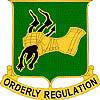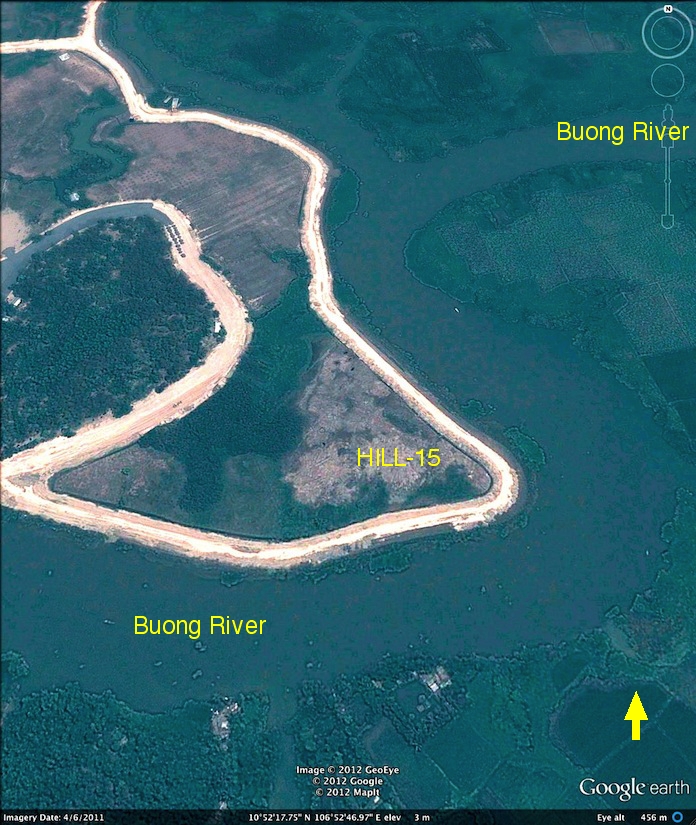

|
~ 720th Military Police Battalion Reunion Association Vietnam History Project ~ |
 |
Outpost on Hill-15 |
|
|
|
|
Most of the more specific details of some of the missions carried out by this unit are incorporated into the chronology of the more comprehensive daily Battalion Time Line from 1967 through September 1970 denoted by |
1967 ~ 1968 |
Located at the intersection of the Bien Go and Buong Rivers along the southern border of the Battalion Tactical Area Of Responsibility (TAOR), Hill-15 was the dominant land feature within the southeastern area. It afforded a commanding view of the TAOR for several miles in all directions as well as control of the Buong and Ben Go Rivers that intersected near its southwestern base. It was the most remote and least accessible of the outpost within the TAOR. Only three means of transportation were available, air, boat, or slogging by foot through rice paddies, two deep tidal streams and swamp. In actuality it was a small island during high tide. Access to the hill could be made by foot, but only through a small area to it's north west at low tide. The hill was utilized as a base for B Company ambush and reconnaissance teams that worked the southeastern sector of the TAOR off and on from early 1968 through early 1969. |
|
Like a small island, the top of the hill was approximately 1 acre sloping down to approximately 3 square acres at its base, surrounded by streams and swamp on the east, north, the Ben Go River on the west and Buong River along the south. It was heavily wooded on the west slope with tall grass and brush on the north, east, and south sides. Just across the Buong River in the 9th Infantry Division and later Thai Army AO to the south, was Little Hill-38. It overshadowed Hill-15 and was often used as an observation point by enemy forces monitoring the MP recon patrols and River Patrol Unit traffic. |
Although there had been rumors during the summer of 1968 about the possibility of making a static outpost on the hill, the decision was not taken seriously until after the 23 February 1969 Post Tet Offensive attack on Long Binh Post. The Main Force Viet Cong Battalions based in the area south of the Buong River attacked along the southern perimeter through the eastern sector of the Battalion Tactical Area Of Responsibility. Another deciding factor was the 28 March 1969 land mine incident resulting in the death of SSG Richard Slaven. |
In 1967 through early 1968 major enemy clearance operations in the area to the south of the TAOR across the Buong River were conducted by elements of the 3rd Brigade, 9th Infantry Division (Bearcat) OPCON to the HQ II Field Forces (Long Binh Post), and ARVN Infantry (Bien Hoa). When the 9th was moved to the Mekong Delta in early 1968 the Royal Thai Army Queens Cobra and later Black Panther Divisions would assume operational control of the area. |
|
|
When the 9th was moved to the Mekong Delta in early 1968 the Royal Thai Army Queens Cobra and later Black Panther Divisions would assume operational control of the area. Throughout 1968 and early 1970 request to convince the II Field Forces HQ command to allow B Company ambush squads to pursue their Viet Cong (VC) and North Vietnamese Army (NVA) antagonist across the river were denied. |
|
|
1969 |
23 February, 0200 hours During the Post Tet Offensive the hill proved to be a valuable piece of real estate. B Company Ambush Team-76 (reinforced to eleven MPs) was positioned on Hill-15. They were able to direct artillery fire onto the enemy 122mm rocket launch location, sapper and infantry forces reinforcing the assault on the southern perimeter of Long Binh Post. The attacking NVA and VC forces originated from the enemy jungle haven south across the Buong River. |
24 February B Company Ambush Team-76 (not reinforced) was again assigned to a night operation on Hill-15. It was still daylight when the team disembarked from the Boston Whalers 400 yards north of the hill. An NVA mortar team already situated on the hill opened fire catching the MPs in the open rice paddies. Counter mortar fire called in by the squad silenced the enemy tube. |
April Construction on the base of operations on the hill began in earnest. B Company ambush teams, to include their fellow scout dog handlers from the 212th MP Company, were moved onto the top of the hill and assigned the weary duty of living there while clearing it of all surrounding vegetation. Unlike the village outpost's, it was Battalion property. |
Construction Begins |
The B Company MPs used C4 explosives, gas powered tools, and plenty of sweat to clear the brush, trees, and dig the holes to be used as the foundations for the future fixed bunkers and defensive positions. |
During the construction phase life on the hill for the MPs was an endless string of long days, and hard physical labor in the unrelenting hot dry sun followed by longer nights under the threatening shadow and the watchful eyes of the local VC and NVA on Little Hill-38, across the Buong River to their south. |
| |
Little 38 was used by the VC and NVA to direct small arms sniper fire and RPG's on the MPs of B Company Ambush Team #76 throughout the 23 February attack on Long Binh Post. Being ever vigilant of enemy presence during this time of construction was routine, being resourceful was a necessity. Although it was frowned upon by headquarters, the MPs of the outpost on Hill-15 would often use the services of the local fishermen and farmers to assist them in transportation. The Vietnamese were happy to assist the MP patrols whose presence kept away the local Viet Cong tax collection teams who would have looted their boats at gun point. |
When the MPs became weary of their daily routine of C Rations, foraging parties were assigned and sent out in search of supplemental Vietnamese mealtime delicacies. For men who stood outpost duty a delicacy was described as ...anything you can eat other than C Rations. The MPs would trade C Rations or pay the local Vietnamese fishermen and farmers in the surrounding area for ducks, fish and shrimp. Using the word shrimp is an understatement, the local fresh water crustaceans were the size of small lobsters and just as tasty. Theses delicacies would be grilled over an open fire and washed down with local or American beer when available. |
Once the hill was cleared and the brush burned away, a supply of sandbags and construction materials were delivered by boat and helicopter in addition to their routine supplies of ammunition, water, and C rations. Two Conex shipping containers, several pieces of corrugated steel culvert pipe, lumber, and tin sheeting, along with what seemed like an endless supply of sandbags were used to construct the bunkers and defensive positions. |
With the removal of all the vegetation on top there was no natural shelter from the relentless hot sun, wind, rain or dust. A trip to the facilities felt like you were sitting in an oven in the hot sun. Rolls of concertina and barbed wire, and cases of Claymore mines and trip flares made up the perimeter. The heavy defensive weapon chosen to crown the hill was a 50 caliber machine gun. |
Upon completion of the OP the ambush teams were rotated for duty on the hill and recon patrols in the surrounding area. Unlike the other outpost in the villages, there were no permanent residents and no PF squad to share the outpost maintenance duties. |
|
2 August All outpost missions in the TAOR were terminated. B Company abandoned the two fortified command post, The outpost on Hill-15 and the outpost on the Finger of Land. The fortifications at both locations were destroyed. The Village Outpost staffed from late 1967, #1 An Xuan, #2 Long Hung, #3 An Hoa Hung and #4 Long Binh Tan, were turned over to the local Popular Forces and National Police. All B Company personnel withdrawn from the facilities were committed to increased reconnaissance and ambush missions within the southern and eastern areas of the Battalion Tactical Area Of Responsibility. |
Miscellaneous Photographs |
Jones, Davenport & unidentifed MPs with 50 cal machine gun. |
|
Jones, Sauss, Davenport digging a gun bunker. |
|
SGT Wiehle on the radio. |
|
PFC Mohollen with his morning cup of coffee. |
|
SP/4 Green & PFC Gagle beat the heat. |
Hill-15 in 2011 |
 |
The hill as we knew it is now gone. It was leveled and the area backfilled for development. The white outline is the bed for a new paved highway running down from an industrial park on what used to be the Finger Of Land. |